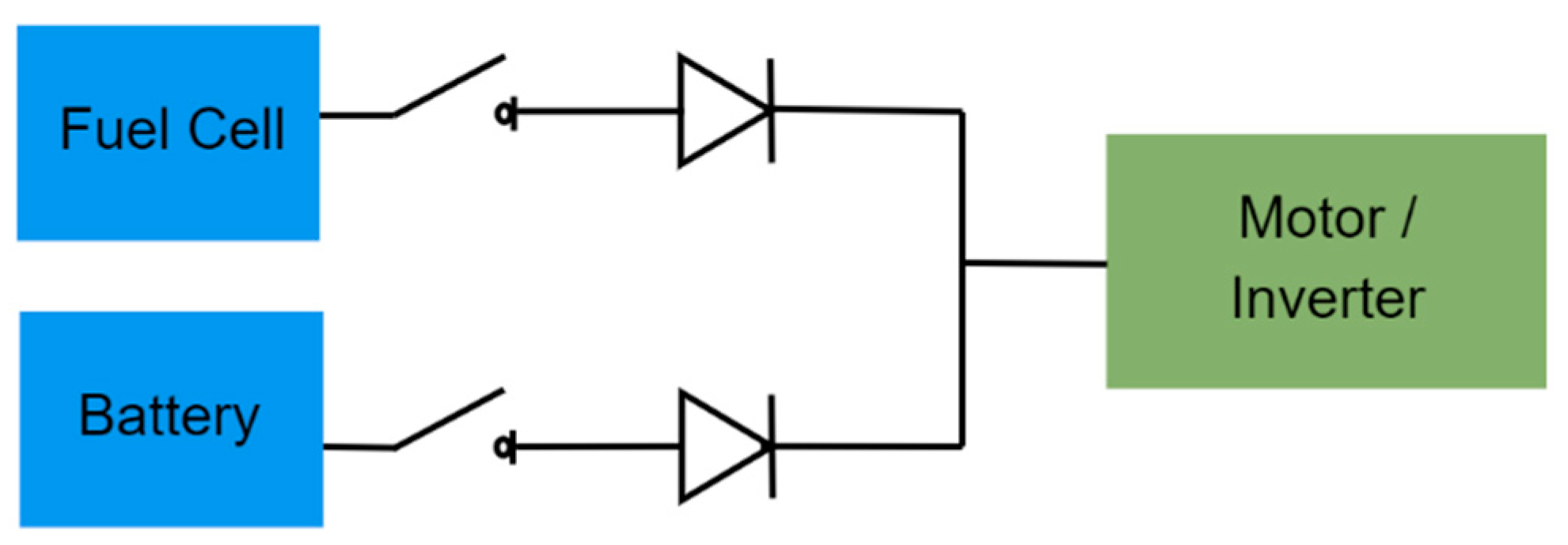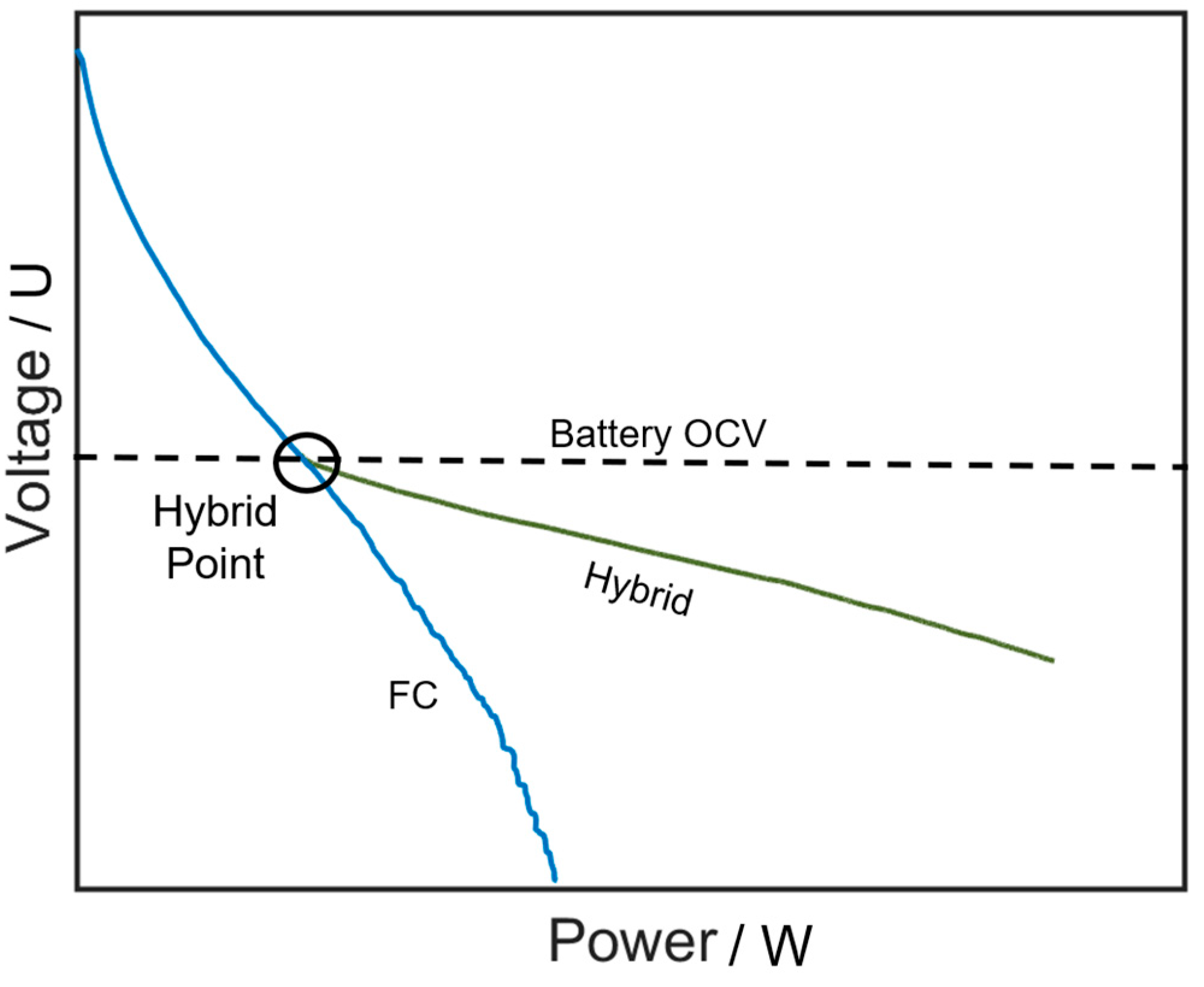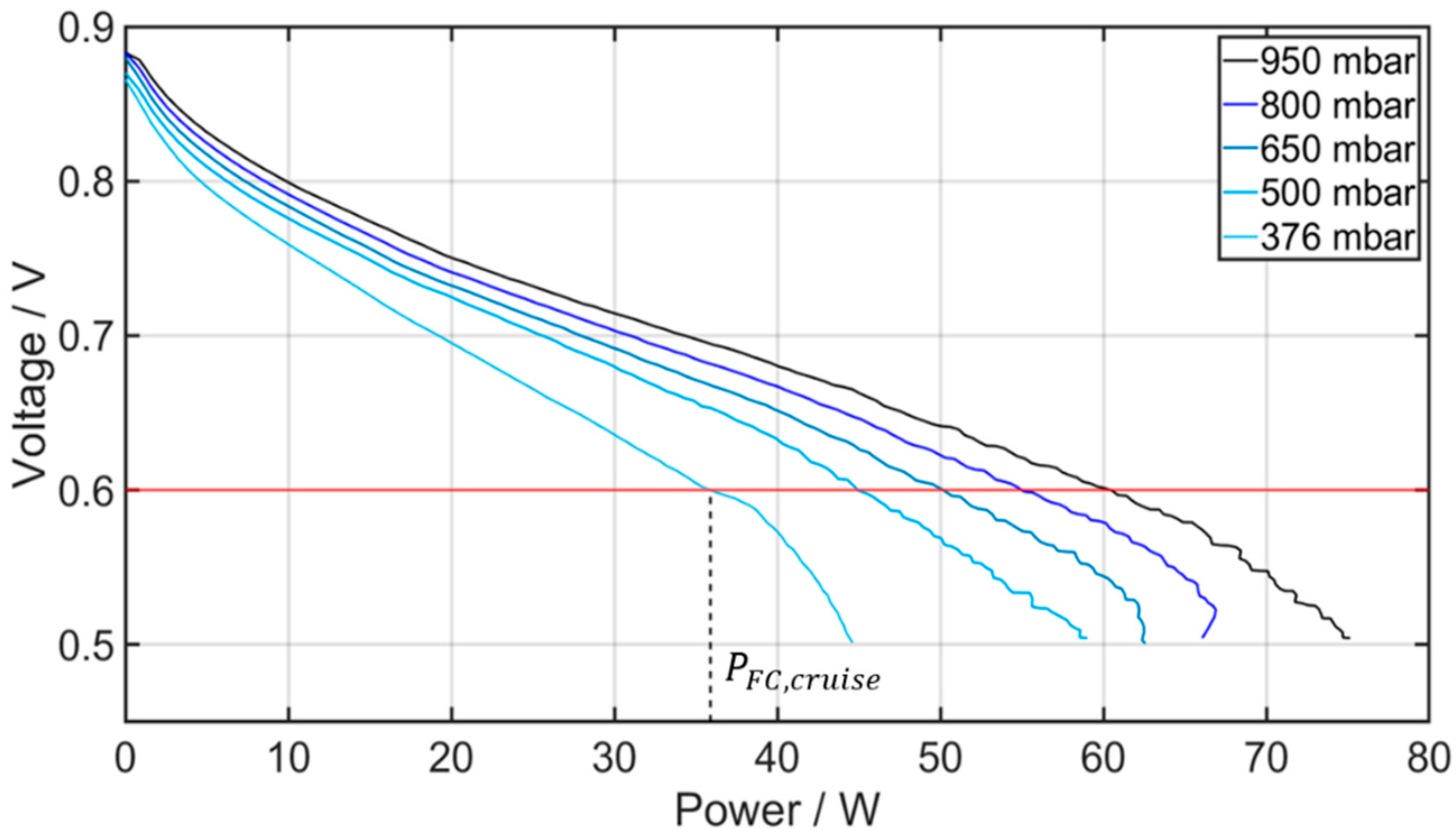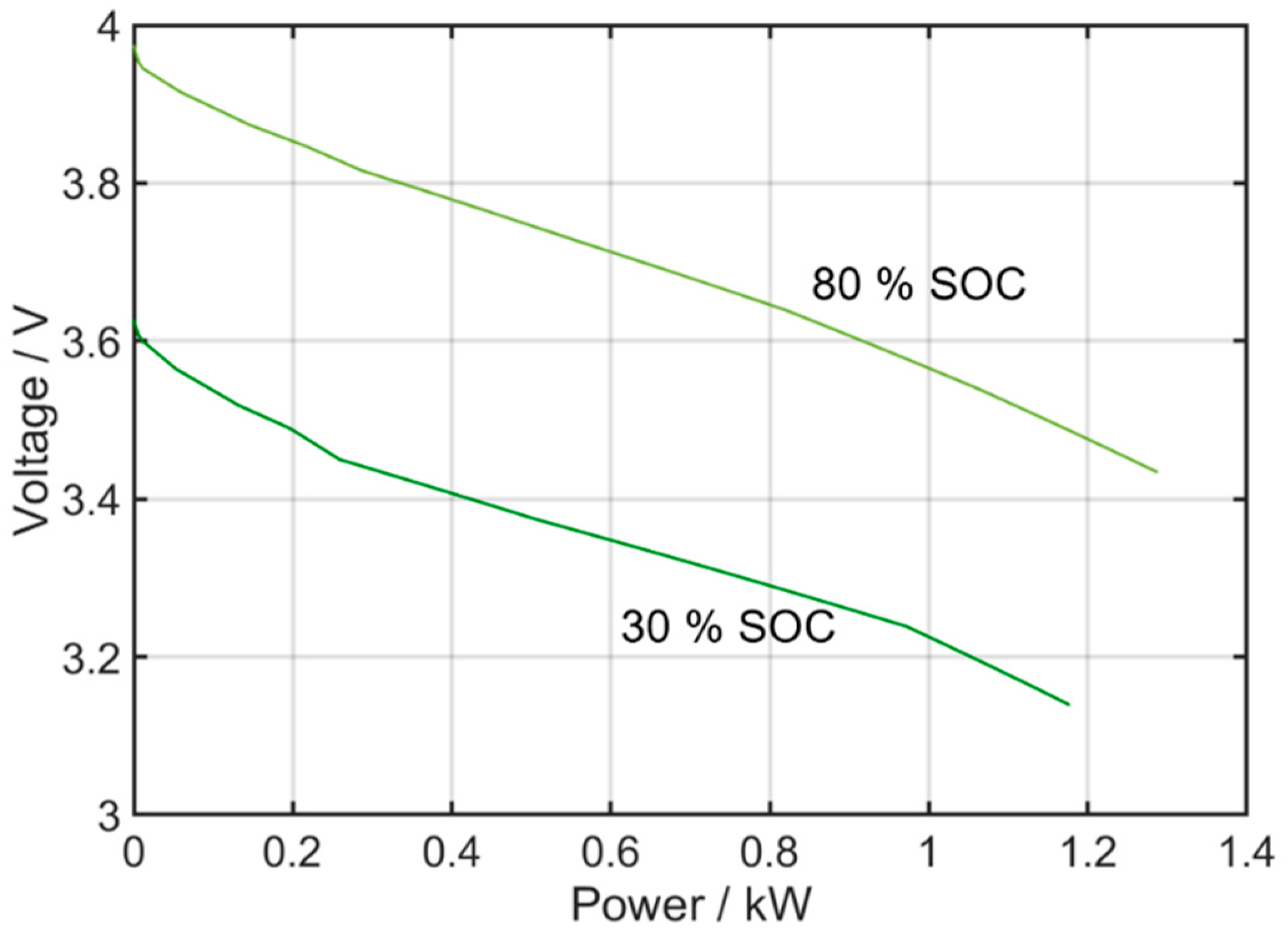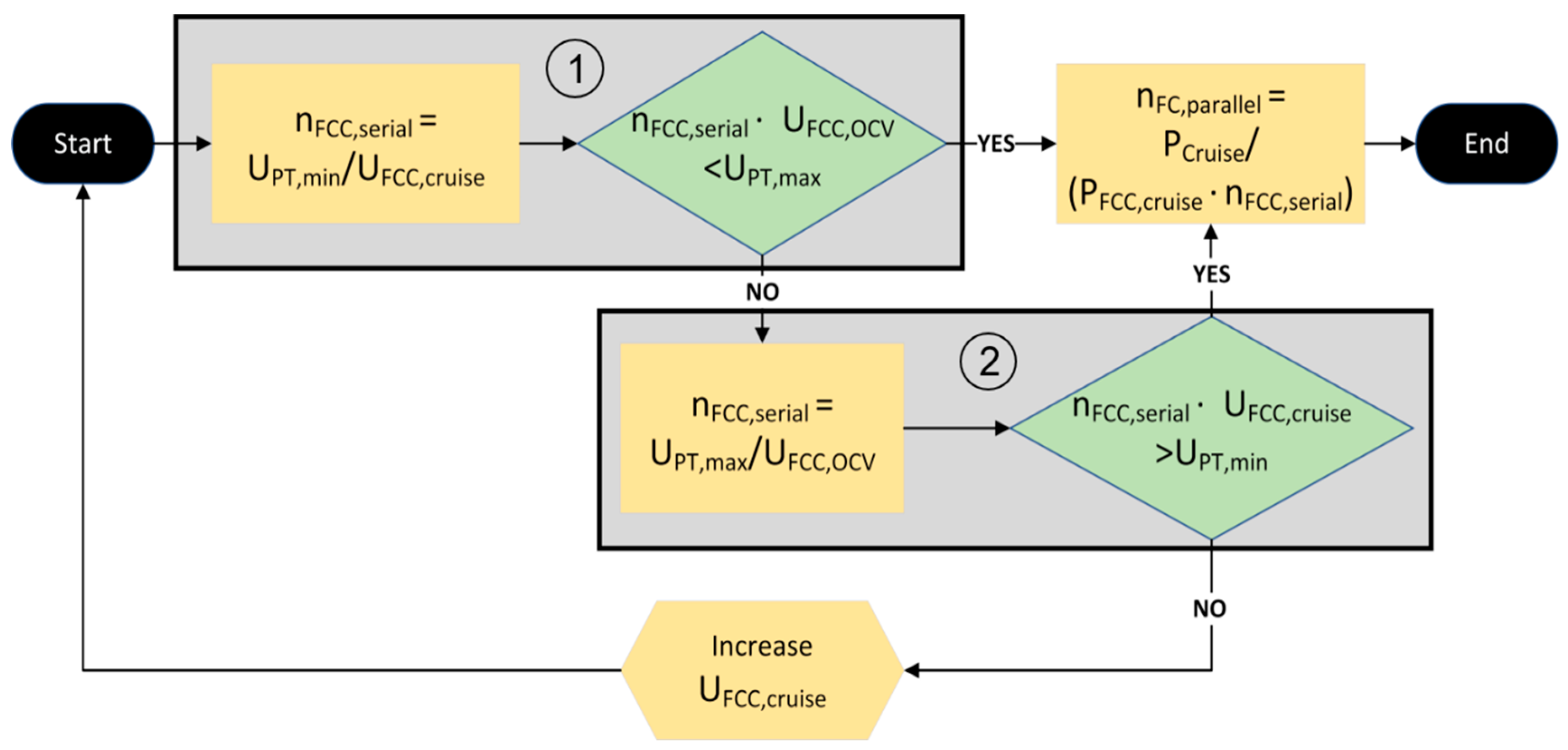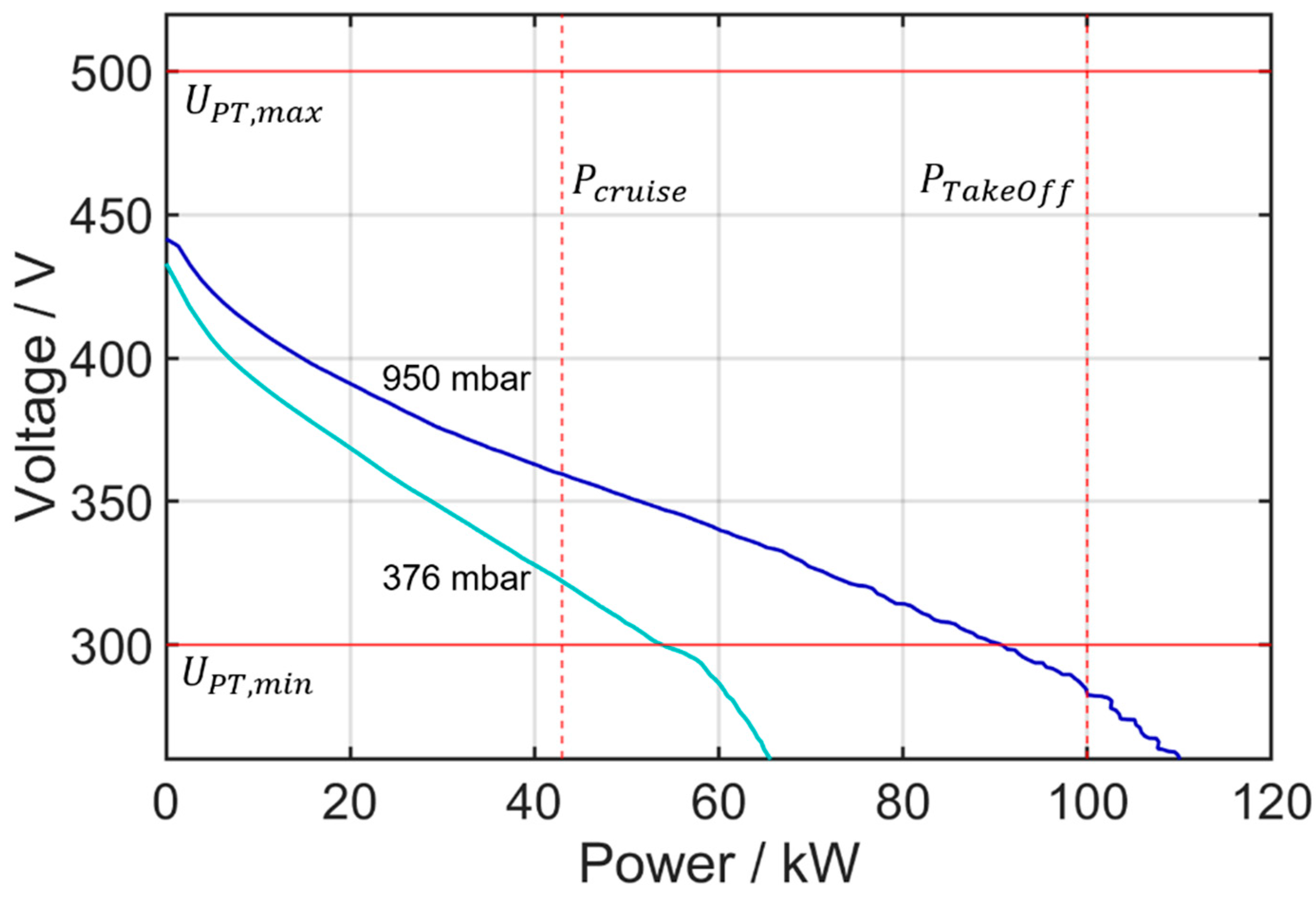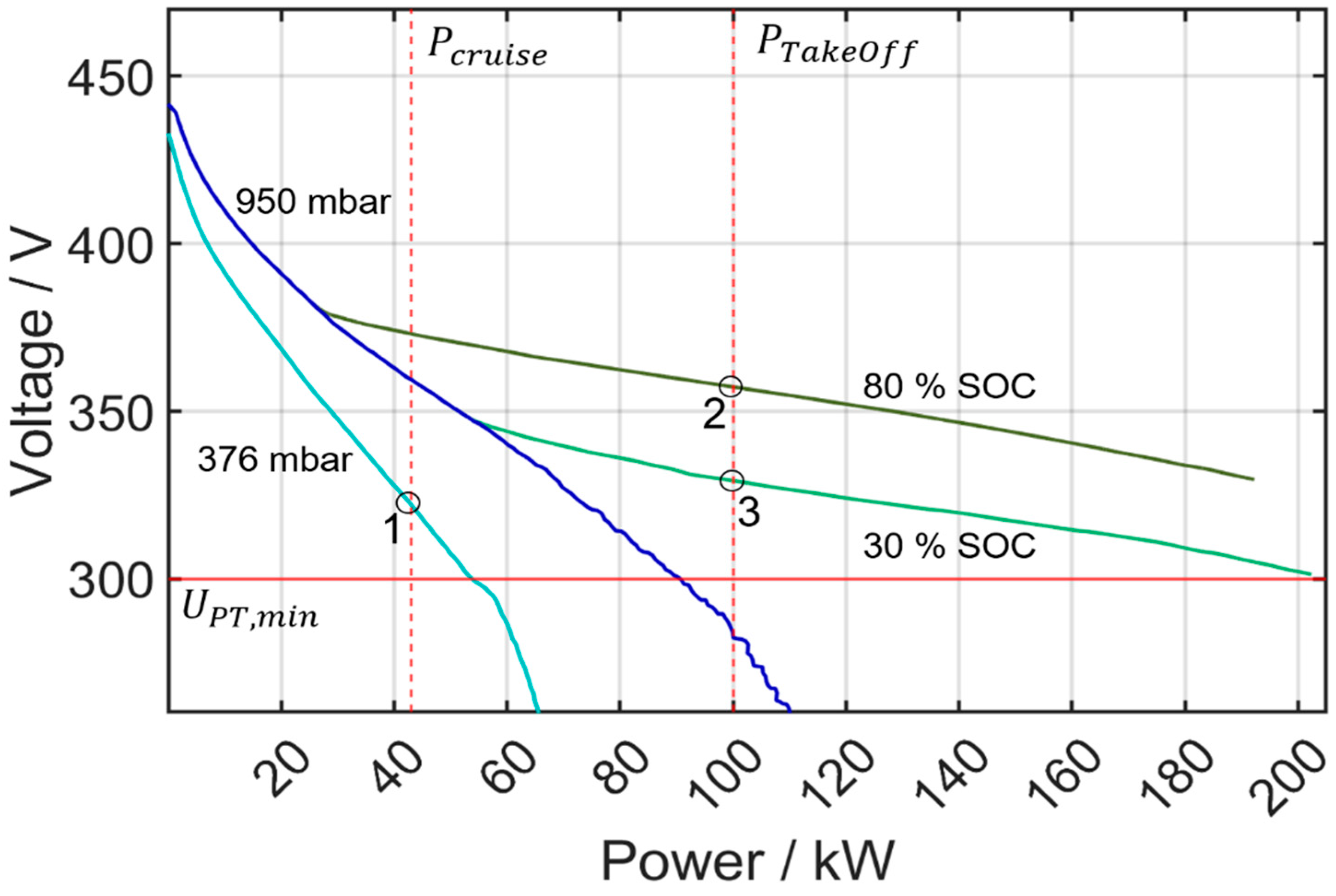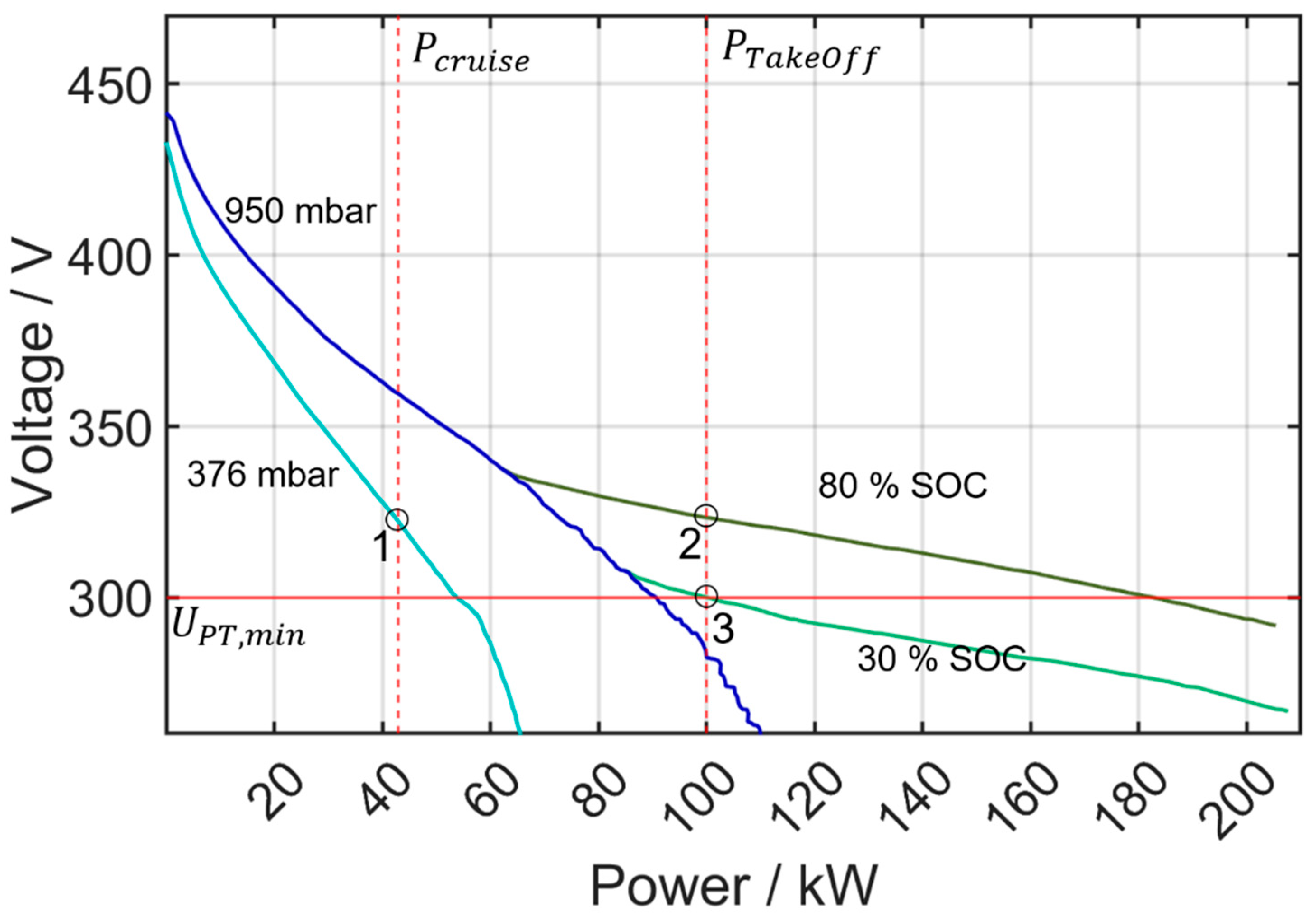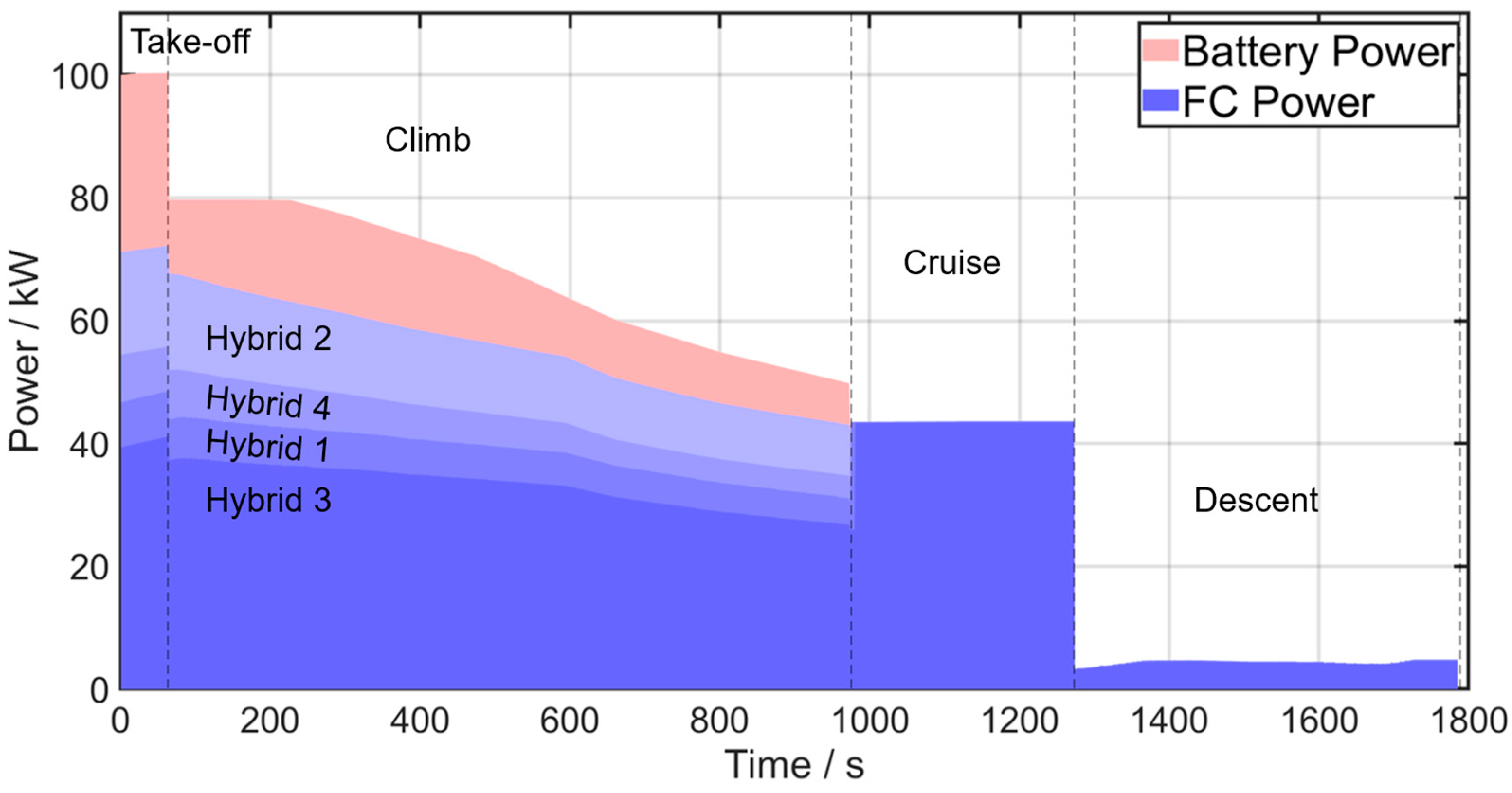1. Introduction
Aviation enables the fast and easy transport of people and goods over long distances. However, the increase in air travel also leads to an increase in the environmental impact of aviation, with aviation-related greenhouse gas emissions contributing to climate change [
1,
2,
3]. To address this issue, the aviation industry is currently exploring new technologies that help to reduce or eliminate harmful and climate-active emissions from aircraft. Two very promising technologies are all-electric or hybrid-electric aircraft [
4,
5]. All-electric aircraft based on batteries as the energy carrier enable emission-less flight. However, they are limited in their range due to the high weight of batteries. Electric aircraft using hydrogen as fuel can fly longer distances and still reduce their emissions considerably [
4,
6,
7,
8]. Emissions of particles, hydrocarbons, sulfur compounds and aromatics are completely eliminated and the only emission is water vapor [
9]. H
2O in the atmosphere also causes a warming effect, but the duration of stay is only in the order of hours to days [
10].
The combination of a fuel cell (FC) and battery in a hybrid propulsion system results in a setup [
5,
11] that avails itself of the high specific power of lithium-ion batteries and the high specific energy content of hydrogen [
12,
13]. This promising sustainable aviation approach can help mitigate the environmental impact of short- and intermediate-distance air travel and make it more environmentally friendly. The storage of hydrogen on board an aircraft comes with its own challenges due to hydrogen’s low volumetric energy density of 600 kWh/m
3 at 200 bar [
14], and its high gravimetric energy density of 33 kWh/kg [
15]. The development of suitable tanks as well as the integration into the aircraft is currently an important research topic [
16,
17]. The usual approach is to connect the fuel cell and the battery into a hybrid system with the help of one or even two DC/DC converters that adapt the voltage levels of both energy sources to that of the load [
18]. There are several studies on the design and sizing of components using DC/DC converters. For example, Ceschia et al. present a numerical design method for a hybrid system with DC/DC for ground application [
19] and Bassman et al. propose a sizing optimization of a DC/DC-based hybrid system with respect to operational costs [
20]. Park et al. also sized a fuel cell battery hybrid system containing a DC/DC for eVTOL [
21,
22].
In a direct-hybrid, however, the fuel cell and the battery are connected directly and without the help of a DC/DC converter that adapts different voltages levels to that of the powertrain [
5,
11]. Removing the DC/DC converter has the potential to improve the reliability, power density and the efficiency of the system [
23]. Safety is crucial in aviation. The hardware as well as the control of a DC/DC converter is complex [
24,
25] and unless a redundant DC/DC converter is used, it represents a single point of failure. A fewer number of critical components, as in a direct-hybrid, results in a more reliable and safer system. Removing the DC/DC can also increase the power density of the system. Adding a DC/DC converter to a system adds weight, not only the weight of the DC/DC converter itself, but also of auxiliaries like cooling. Even though DC/DC converters can have a relatively high efficiency of over 96%, considerable losses occur if the full propulsive power has to be converted [
26]. The resulting heat has to be removed and the cooling of the DC/DC converter is necessary in adding to the cooling demand of the entire system. A bigger cooling system adds weight to the total-hybrid propulsion system as well as additional drag due to the heat exchanger that transfers the heat to the surrounding air [
27].
In a direct-hybrid, the system voltage of the powertrain for propulsion depends on the sizing and operational behavior of the fuel cell and battery. The fuel cells and batteries both change their operating voltage levels at different operating conditions, which strongly affects the behavior of a direct-hybrid system and therefore the available performance [
28,
29]. Designing those two components for a direct-hybrid requires a detailed knowledge of the exact fuel cell and battery behavior. In particular, the voltage power curves of the fuel cell and the battery at different operating conditions are of interest. Aircraft operate at different altitudes, resulting in the powertrain being exposed to varying ambient pressures [
30]. These low operating pressures strongly affect the performance of a non-pressurized fuel cell. At low-ambient pressures, the fuel cell power at the same voltage level decreases [
31,
32,
33]. The voltage level of the battery is almost independent of pressure but is determined by the state of charge and the discharge rate [
34]. The influence of the operating parameters on the behavior of fuel cell and battery needs to be considered, as well as any voltage limitations of additional powertrain components like the inverter/motor unit or auxiliaries and, of course, the power required for a specific flight mission profile [
29]. Cruise altitude and required power during cruise are therefore relevant factors for the sizing of the fuel cell system. During cruise, the aircraft should only be powered by the fuel cell to enable a long flight range and to make the best use of the high specific energy of hydrogen. During flight phases with a high-power demand like take-off and climb, the battery power supports the fuel cell power. Due to the short duration of these flight phases, however, the energy content of the batteries can be comparatively low and the lower specific energy of batteries is not that significant. To ensure that during cruise the entire power is provided by the fuel cell, a power management system [
5,
11] consisting of switches is required that can disconnect the battery if necessary. For additional low power systems and auxiliaries which require voltage at a much lower level (e.g., 28 V) like the avionic system, DC/DC converters are still required. These, however, will be much smaller and lighter than a DC/DC converter that converts the entire propulsive power.
The concept of a direct-hybrid has been described previously [
5]. There are studies on the design of a direct-hybrid system consisting of a fuel cell and a battery. For example, Jarry et al. described a model-based, numerical sizing approach for a direct-hybrid system for aviation in a non-propulsive function. The fuel cell is modeled via a polarization curve but the influence of varying ambient pressure in aviation is not considered [
35]. The influence of battery SOC and operational pressure of the fuel cell on the characteristic hybrid curves has been examined previously [
28,
29]. However, the consequences with regard to the required sizes of fuel cell and battery as well as the optimal configuration for a propulsive direct-hybrid system for aviation have not been examined yet. In this work it is demonstrated how the fuel cell system and the battery in a direct-hybrid system can be designed and optimized for a known mission power profile, taking into account the relevant behavior of the fuel cells and the batteries. After a first preliminary calculation of a hybrid configuration, the size of battery and fuel cell are optimized to reduce oversizing. After defining different possible system configurations that can meet the power demand of a specific mission profile, it is examined how the different hybrid configurations affect the required energy amount that is provided by the battery during take-off and climb, as well as the resulting hydrogen consumption. In addition to this, the fuel cell and battery weight for the different configurations is analyzed and compared.
2. Direct-Hybrid
The combination of a battery and a fuel cell in a hybrid provides a propulsion system that delivers high power when the demand peaks, while taking advantage of the high specific energy of hydrogen during phases with a lower demand. In a direct-hybrid, the fuel cell and the battery are connected to a powertrain, as shown schematically in
Figure 1, without the use of a DC/DC converter. Diodes are installed to prevent the current from flowing backwards into the fuel cell or the battery. If a charging function of the battery is to be included in the system, the diode in the battery path has to be bypassed or eliminated.
In a setup as shown in
Figure 1, the voltage levels in the system are determined by the voltage levels of the fuel cell and the battery.
Figure 2 schematically shows the characteristic curve of a fuel-cell-only system (blue line) and the characteristic curve for a direct-hybrid system (green line) in which the fuel cell is combined with a battery in the configuration as shown in
Figure 1. The graphic also shows the open circuit voltage (OCV) of the battery.
At low power levels, only the fuel cell supplies power. As power demand increases, the fuel cell voltage decreases in the hybrid system until it reaches the OCV of the battery. At this point, referred to as the hybrid point, the battery begins to deliver power as well. At higher power levels (to the right side of the hybrid point in
Figure 2), both the fuel cell and the battery supply power, resulting in a less pronounced gradient of the characteristic curve compared to a fuel-cell-only curve as well as a higher power output. Connecting the battery to the system stabilizes the voltage level, which leads to a higher system voltage level at the same power due to the voltage of the battery [
29].
If the battery is used during cruise, it is discharged which reduces the range of flight. To maximize the utilization of the fuel cell during long-term low power phases and save the energy from the battery for flight phases with high power demand, the battery can be disconnected from the system by opening the switch that connects it to the powertrain (see
Figure 1). When the switch is opened, the entire power is drawn from the fuel cell. In the case of high-power outputs (to the right side of the hybrid point) this leads to a lower voltage at the equivalent power level than in hybrid mode, as can be seen from
Figure 2. Still, the battery should be disconnected whenever the fuel cell is capable of delivering the power on its own.
4. Mission Profile
The parameters of the flight mission, its cruising altitude and required take-off and cruise power determine the requirements for the powertrain. The altitude has a direct impact on the operating conditions (especially the cathode pressure) that the fuel cell is exposed to. The maximum power is determined by the take-off power which is the power output that the direct-hybrid system must deliver, while the cruise power determines the power that must be provided from the fuel cell only.
To demonstrate the process in which a direct-hybrid system can be designed, an example mission profile based on the shaft power of a 40-seater aircraft of the Do328 class was used. The cruising altitude considered was 25,000 ft, which corresponds to an ambient pressure of 376 mbar [
30]. The original mission profile, with a maximum power of 4096 kW was provided by Deutsche Aircraft GmbH. The shaft power profile was scaled down to a maximum power of 100 kW, as can be seen in
Figure 5, to stay within the limits of the lab setup for later experimental analysis [
29]. For upscaling and meeting the higher power demand of for example the Do328, the used hybrid module, consisting of fuel cell system and battery, would be implemented multiple times to meet the total required power. This modular approach also aids with the required redundancy in aviation.
The profile from
Figure 5 consists of four sections: take-off, climb, cruise, and descent. The shown cruise phase is shortened and can be extended based on the distance that the aircraft should travel or the amount of hydrogen that is available. During cruise, it is advisable to provide full power only from the fuel cell system to fully use the high specific energy of hydrogen and increase the range of the all-electric aircraft. During take-off and climb, when additional power is needed, the additional power is supplied by the battery that has a high specific power. This makes it possible to avoid the oversizing of the fuel cell. During descent there is a low power demand. This can easily be met by the fuel cell alone and it is also possible to recharge the battery.
7. Mission Profile Analysis
In order to analyze the performance and contribution of the fuel cell and the battery during different phases of the flight for the different direct-hybrid systems defined in chapters 5 and 6, a flight mission was calculated with the scaled power profile from
Figure 5 and a shortened cruise time of 300 s. The flight mission calculation was implemented in Matlab. For each second of the mission profile the corresponding hybrid curve and the operation point was calculated. The power usage was integrated over time to obtain the energy used. For each hybrid configuration discussed in
Section 5 and
Section 6, an energy calculation over the complete mission profile was performed. The hybrid configurations are again summarized in
Table 1, where the respective fuel cell and battery configurations are shown.
Hybrid 1 was designed considering the minimum voltage of the fuel cell at cruise conditions and assuming that a parallel scaling of the fuel cell can only be completed in whole numbers as described in chapter 5. The battery configuration was determined by setting the minimum battery voltage at its highest discharge rate to the minimum voltage of the powertrain.
For hybrid 2, the battery size was optimized to exactly match the minimum voltage of the powertrain of 300 V at 100 kW with a 30% SOC by reducing the number of serial cells by 11 in comparison to hybrid 2.
For hybrid 3, the fuel cell size was reduced by assuming that a parallel scaling of the stack by 2.4 is possible. This corresponds to a new stack development with a different active area of the cells.
In hybrid 4, the battery size was also adjusted to match the smaller fuel cell size, by reducing the number of cells by eight (hybrid 3).
Figure 12 shows the results of the flight calculations as a stacked area plot. To refer to the different hybrid configurations in the plot, the numbering from
Table 1 is used. For each calculation, the SOC of the battery was set to 80% at the beginning. The graph is vertically divided into four sections representing the different flight phases. After climb, the battery is disconnected and all power is supplied by the fuel cell for cruise and descent. The blue areas in
Figure 12 visualize the fuel cell power of each hybrid configuration. The red area is always provided by the battery. The graph shows that during take-off, the battery power is highest compared to the lower power levels during climb. When the power demand is reduced, the battery share decreases. During cruise the propulsive power is provided by the fuel cell in all cases, since the battery is disconnected. During take-off and climb, however, hybrid configuration 2 has the highest share of fuel cell power, while in hybrid configurations 1, 3 and 4, less power is provided from the fuel cell during take-off and climb than during cruise. It can also be seen that during take-off, the fuel cell power increases slightly. This is due to the fact that the battery is discharged and its voltage decreases accordingly. This effect can be observed for all hybrid configurations but is strongest for hybrid 3 (power increase from the fuel cell of 1.7 kW). For hybrid 2, the increase of fuel cell power during take-off is only 0.9 kW. At the beginning of the climb phase, there is a period of constant power at 80 kW. During this period, the proportion of battery power increases while the fuel cell contribution for all hybrids considered in this study decreases. During the climb phase, the aircraft gains altitude (see
Figure 5) which results in a decrease in ambient pressure. This in turn decreases the fuel cell power as shown in
Figure 3. The power supplied by the fuel cell at higher altitudes decreases for the same system voltage, and a greater proportion of the power needs to be supplied by the battery.
Hybrid configurations 1 and 2 both operate with three parallel fuel cell stacks. When the battery size is reduced from 96 (hybrid 1) to 85 (hybrid 2) cells, a strong increase in the fuel cell contribution can be seen. An increased fuel cell share results in a lower amount of energy being drawn from the battery and therefore less energy needs to be stored in the battery. Over the entire calculated mission, 22.9 kWh of energy is consumed. For hybrid 1 (that uses a 96-cell battery and three parallel fuel cell cells), the battery will in total provide 8.1 kWh of energy during take-off and climb. For hybrid 2 with the reduced battery size of 85 cells, the energy provided by the battery during take-off and climb is only 3.5 kWh. This is a 57% reduction in energy provided by the battery. The energy used from the battery and the SOC after take-off and climb for all four hybrids are given in
Table 1. For all calculations, the battery SOC at the start of the calculation is 80%. For hybrid 1 (with 96 battery cells), the SOC drops to 52.7% at the end of the climb phase. For hybrid 2 with the reduced battery of 85 cells, the SOC after the climb is 67.2%. Despite the smaller battery, the SOC at the end of the climb phase for this configuration is higher than for hybrid 1.
Hybrid 3 and 4 both have an exemplarily designed and reduced fuel cell, which is not commercially available. The number of serial cells remained the same, but the connection in parallel was scaled down to correspond to 2.42 parallel cells. The power distribution was calculated for hybrid 3 with a battery size of 96 cells and for hybrid 4 with 88 battery cells. The results are also shown in
Figure 12 (hybrid 3 and 4). Again, the power contribution of the fuel cell increases as the number of battery cells decreases and due to the higher contribution from the fuel cell, the energy provided by the battery decreases. For hybrid 3 with 96 battery cells, 9.6 kWh is drawn from the battery. For hybrid 4 with only 88 cells, 6.6 kWh are provided by the battery. This corresponds to a reduction of 31%. For hybrid 3 with 96 cells, the SOC drops to 47.2% after take-off and climb which is the lowest of all four systems. For hybrid 4 with 88 battery cells, the SOC after climb is at 55.7%. Here again, it is interesting to note that a reduction in battery size results in a higher SOC after take-off and climb due to the higher contribution from the fuel cell.
The hybrid configurations 1 and 3 differ in their fuel cell sizes but have the same battery size (96 cells). It can be seen from
Figure 12 that a smaller fuel cell leads to a higher contribution from the battery during take-off and climb. The energy required from the battery during take-off and climb is 1.5 kWh higher for hybrid 3 with the reduced fuel cell size than for hybrid 1. The parallel scaling of hybrid 3 is smaller, resulting in a steeper polarization curve. The steeper fuel cell curve leads to less current being provided by the fuel cell at a certain voltage, which in turn results in an increased battery share in a direct-hybrid system.
When comparing hybrid configuration 2 and 4, which have differently sized fuel cells and a minimized battery each, the same effect on the power share of the fuel cell is seen. The fuel cell power contribution of hybrid 4 with the smaller fuel cell system (2.42 parallel cells) is lower compared to hybrid 2 with the larger fuel cell (3 parallel cells). This results in an increased usage of the battery. For take-off and climb, 3.1 kWh more energy is required from the battery for hybrid configuration 4 compared to hybrid 2.
The results demonstrate the need for optimizing the battery system and the potential for weight reduction while optimizing performance. Minimizing the size of the battery will reduce the weight of the system and can therefore increase the range or payload of a direct fuel cell hybrid aircraft. However, a smaller battery will require a larger fuel cell and an optimum, with respect to performance and weight, needs to be found. Aiming for a large fuel cell alone will not necessarily result in a light-weight system. To examine how the optimization of the fuel cell and the battery sizes can lead to a light-weight system, the weight for each system was assessed. The battery used for the considerations above is a high energy cell and one cell weighs 1.53 kg. For the fuel cell, a power-to-weight ratio of 3 kW/kg is assumed, which corresponds to an intermediate value of the range given by Tashie-Lewis et al. [
37] for state-of-the-art systems. To calculate the fuel cell weight, the rated power of the fuel cell is used and divided by the specific power of 3 kW/kg.
In
Table 1, the resulting calculated weights of the fuel cell, the battery and the total weight for each hybrid configuration are shown. By reducing the number of battery cells from 96 cells to 85/88 cells, the weight of the battery cells is reduced by 16.8 kg/12.2 kg. Reducing the parallel scaling of the fuel cell from 3 to 2.42 parallel cells leads to a weight reduction of 9.7 kg. It can be seen from
Table 1 that hybrid 4 is the lightest configuration, despite the fact that hybrid 4 has a larger battery and smaller fuel cell compared to hybrid 2.
Table 1 also shows the total calculated hydrogen consumption over the examined mission duration for each configuration. The hydrogen consumption was calculated from the fuel cell current, assuming an anode stoichiometry of one. The smallest amount of hydrogen is consumed in hybrid 3, which required 0.74 kg for the calculated mission. The highest amount of hydrogen, which is 1.12 kg, is consumed with hybrid 2. This is a difference of 0.38 kg compared to hybrid 3. However, the data from
Table 1 shows that the correct sizing of fuel cell and battery has a much higher weight saving potential compared to the saving in hydrogen weight. Minimizing the weight of the propulsion system in an electric aircraft is important, since weight has a quadratic impact on the required power to maintain steady level flight and a heavier propulsion system reduces the payload [
38]. The detailed sizing and analysis of the fuel cell and battery is therefore important for optimizing the performance in an all-electric aircraft.
This chapter showed how the designed hybrids (1–4) behave during a realistic mission with regard to the power and energy consumption out of the fuel cell and the battery. It was found that the different configuration showed a different share of fuel cell and battery contribution during take-off and climb. For all four systems the fuel cell share increased as the battery discharged; however, this effect is stronger when the overall battery contribution is greater. It was also observed for all configurations that the fuel cell power share decreased as the aircraft climbed due to lower ambient pressures. When comparing the different configurations, it was found that a smaller battery led to a higher SOC after climb, since more energy was provided from the fuel cell. Therefore, the smaller batteries maintained a higher SOC after climb. The weight analysis of the different configurations showed that the smallest battery does not automatically lead to the lightest system. Oversizing the fuel cell in order to reduce the size of the battery does therefore not lead to a lighter system. Assessing the weight of the consumed hydrogen for the different configurations showed that any savings on hydrogen were small in comparison to the weight saving potential due to an optimal sizing of the fuel cell and battery. The obtained configurations and results are valid for the examined flight profile. A different ratio between the maximum power demand at take-off and during cruise will result in different fuel cell and battery sizes.
8. Conclusions
In a fuel-cell-based direct-hybrid system, a fuel cell and a battery are connected in parallel without a DC/DC converter. The voltage levels in the system are therefore directly determined by the choice and design of the fuel cell and battery. The presented work introduces a new method to determine and optimize the size of the fuel cell and battery in a direct-hybrid for aviation, considering the varying behavior of the battery and the fuel cell due to battery SOC and pressure dependency of the fuel cell. The method was used for designing several possible hybrid configurations, which were then compared with respect to weight and energy consumption from the battery and fuel cell.
A direct-hybrid system, based on the operational data of a PEM fuel cell (type HD10, Cummins Inc., Columbus, IN, USA) and a lithium-ion battery (type SLPB120255255, 75 Ah pouch, Kokam Co., Ltd., Suwon, Republic of Korea), was designed and optimized to fit the power demand of a realistic flight mission power profile. The power profile was based on the shaft power of a 40-seater aircraft of the Do328 class, which was scaled down to 100 kW.
The direct-hybrid system was designed so that both the fuel cell and the battery provide power during high power phases like take-off and climb. During the lower power phases like cruise and descent, the battery is disconnected and the fuel cell alone supplies power in order to make the best use of the high specific energy of hydrogen and to enable a long flight range. For a non-pressurized fuel cell system, the pressure dependent performance at high altitudes must be considered. As there is no DC/DC converter in this hybridization concept, the voltages of the fuel cell and the battery must match, and voltage boundaries of other components in the powertrain like the inverter motor system must not be exceeded.
A method on how this is achieved was presented and used to determine the required fuel cell size for the exemplary system. Based on the voltage limits of the powertrain and the characteristic fuel cell curves at low pressures, it was found that 500 fuel cells in series are required. In order to meet the cruising power demand of 43 kW at a cruising altitude of 25,000 ft, a parallel scaling of the 500-cell fuel cell stack of at least 2.4 is required. A parallel scaling of 2.4 is only possible with a stack redesign. Therefore, two fuel cell configurations were chosen for further analysis: One with three 500-cell stacks in parallel and one with a 2.4 scaling.
For determining the battery size, the dependency of battery voltage on SOC and discharge rate was considered. A maximum and minimum SOC of 80% and 30%, respectively, were considered and by setting the minimum voltage of the battery at its highest discharge rate to the minimum voltage of the powertrain, a required battery size of 96 serial cell was calculated. It was found, however, that in the hybrid system this method led to an oversized system. By adapting the battery size to the minimum voltage of the hybrid powertrain at take-off power instead, the battery size could be reduced to 85 battery cells for 3 parallel fuel cell stacks and to 88 for 2.4 parallel fuel cell stacks. The reduction in the size of the fuel cell therefore led to an increase in the minimal size of the battery.
To analyze the performance of the different hybrid configurations during take-off and climb, flight calculations were then performed. By analyzing the energy and power contributions from the fuel cell and battery, it was shown that for a system with three parallel fuel cells reducing the battery from 96 to 85 cells reduced the energy provided by the battery by 57%, resulting in a higher SOC after climb for the smaller battery (67% instead of 53%). This shows that by reducing the battery size while maintaining the fuel cell size, the battery energy usage is reduced and the SOC after climb can be increased because the fuel cell’s contribution increases. Similarly, a scaled down fuel cell and constant battery size increased the battery usage during take-off and climb leading to a lower SOC after climb. For the scaled fuel cell system (corresponding to 2.42 parallel fuel cells) the battery share increased compared to three parallel fuel cell cells by 19% when combined with 96 battery cells.
The reduction in weight is important for aircraft performance and flight range. By optimizing battery and fuel cell sizes, the weight of those two components can be minimized while still meeting power requirements and voltage limits. The weights for the different hybrid configurations were assessed and the hybrid configuration with 2.42 parallel fuel cell cells and 88 battery cells was found to be the lightest of all the systems, even though it was not the configuration with the smallest battery. It is the system where first the fuel cell and then the battery were optimized to be as small as possible, while staying within the voltage limits.
The results show a method how the fuel cell and battery in a direct-hybrid can be designed for a specific application and power profile, considering the altitude and its influence on fuel cell performance, the dependency of the battery performance on SOC and current, as well as the current and voltage limitation of the powertrain. It also shows how the fuel cell and battery size can be optimized in order to reduce the weight of the system while meeting the performance requirements. In future, the influence of varying operating temperatures as well as the dynamic behavior of the system and the consequence that might have on the sizing of the components should be examined as well.
